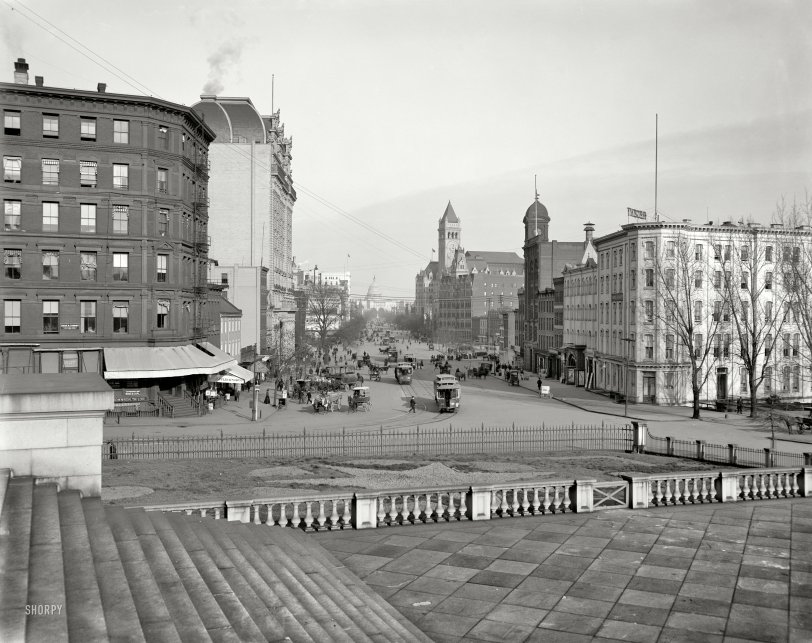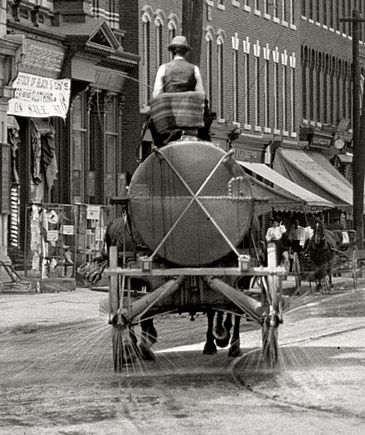


Framed or unframed, desk size to sofa size, printed by us in Arizona and Alabama since 2007. Explore now.
Shorpy is funded by you. Patreon contributors get an ad-free experience.
Learn more.

- Freeze Frame
- Texas Flyer wanted
- Just a Year Too Soon
- WWII -- Replacing men with women at the railroad crossing.
- Yes, Icing
- You kids drive me nuts!
- NOT An Easy Job
- I wonder
- Just add window boxes
- Icing Platform?
- Indiana Harbor Belt abides
- Freezing haze
- Corrections (for those who care)
- C&NW at Nelson
- Fallen Flags
- A dangerous job made worse
- Water Stop
- Passenger trains have right of way over freights?
- Coal
- Never ceases to amaze me.
- Still chuggin' (in model form)
- Great shot
- Westerly Breeze
- For the men, a trapeze
- Tickled
- Sense of loneliness ...
- 2 cents
- Charm City
- What an Outrage
- Brighton Park
Print Emporium
Pennsylvania Avenue: 1902

"Pennsylvania Avenue, Washington, 1902." Landmarks in this view from the Treasury steps at 15th Street include the Capitol and Old Post Office. On the bill at Chase's Polite Vaudeville: Capt. Woodward's trained seals. 8x10 inch glass negative by William Henry Jackson, Detroit Publishing Co. View full size.
A look at nearly the same view, today.
The clock-tower is still there, luckily enough.
Little else however; progress, I suppose.
Not a Horse Car
I suggest that streetcar 35 is not an old horse car, but rather an old cable car being used as a trailer behind the new electric car. The doorway in the dasher was to make it easier to change the grip. Today's San Francisco cable cars have the same feature, but the door is usually closed.
A nifty and oft-reproduced view
A survey of historic postcard views from this same location can be found here.
Horse Car Trailers
By the mid-1890s Washington ordered conversion of horse cars to electric power. The last horse car ran in April of 1900. This view shows new electric cars pulling smaller horse cars as trailers, a common feature in early days of conversion to electric streetcars. Of interest is the new Washington streetcar system will use overhead trolley lines, as opposed to the earlier conduit system (underground power supply). DC even had a brief fling with cable cars.
[The "new" D.C. streetcar system used an underground power supply. -Dave]
One Automobile
Only one automobile - and already they can't park for diddly!
Dodge 'em
kvenido mentioned all the street daredevils. A while back Dave posted a video of a film taken in San Francisco right before the 1906 earthquake. It was filmed from the front of a trolley, just one near hit after another.
We've seen pictures of the train that used to travel down Tenth Avenue in Manhattan. There were over 400 people killed by that train during the time it ran.
Life was cheap, I reckon.
A Possibility
My guess for the tank? Either for road tar, or, probably more likely for that era, cesspool cleaning.
[Or water for street cleaning. - Dave]
That actually makes me think of another possibility (which I've learned from reading newspapers of that era), when some cities used water to get the dust to lay down during dry spells. However, given that the streets were predominantly paved in the area, washing seems to be the correct answer.

Amazing!
It is a PERPETUAL wonder to me that in these old pictures everyone seems to be in the streets (horses, people, buggies, trams-you name it) and they (seemingly) don't collide with each other. Clearly there were no monitoring police or crosswalks-how the heck did they manage it?
Willard's Hotel
Visible just down the street, on the left. Site of decades of political intrigue. Charles Templeton Strong famously said of Washington, "Beelzebub reigns there, and Willard's Hotel is his temple."
























On Shorpy:
Today’s Top 5